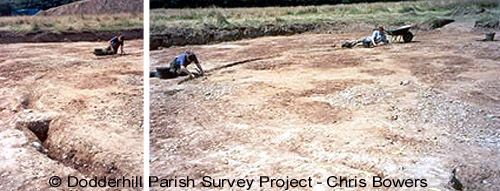More information on the Later prehistoric period in Dodderhill
Iron Age Britain is usually regarded as a tribal society, and Dodderhill would normally be considered to have been within the territory of the Dobunni. This territory is usually regarded as covering much of the Cotswolds, as well as the middle to lower Severn valley. Since this area is dominated by hillforts, it is usually thought that these sites were of primary social and economic importance as centres of power and organisation. A local example would be Hanbury, where a hillfort covers the higher ground later occupied by the parish church. No such major defensive site has ever been discovered in Dodderhill parish, and so Hanbury should be taken to be the local hillfort site.

Photographs of an Iron Age round house, identified by the roof overhang precipitation drip-ditch. The archaeology was undertaken prior to the building of the Centurion Way housing development.
Lowland settlement can be expected in the form of small isolated farmsteads, and an example has only recently been discovered on the south side of Wychbold village. Here there was a small settlement consisting of up to three roundhouses which were mainly occupied in the middle to later Iron Age. The relatively few finds is typical of other sites across this part of the west Midlands. There was domestic pottery and sherds of salt containers from Droitwich. Other sites of this period are most likely represented by traces of possible enclosure ditches detected during geophysical survey to the south of Crutch Lane, and by cropmarks recorded during aerial photography.
Flourishing agriculture, owing to a warming climate, would be expected, and Wychbold presumably formed part of this agricultural system. An additional resource, on the southern boundary of Dodderhill, was the main brine springs, but no intensive settlement has been found here for the Iron Age period, and so seasonal salt making may have occurred, with the salt makers travelling in each day from nearby settlements. Quantities of salt will have been transported through Dodderhill for instance along Crutch Lane. The wider than usual range of pottery in Iron Age Droitwich suggests that the salt was a catalyst to local trade, pulling in products from a larger than usual trading/exchange zone. Occasional finds of Iron Age coins are also known, such as a gold stater. Iron Age finds are not normally represented from fieldwalking assemblages, and this negative evidence may be misleading as the pottery is generally less obvious in colour and more friable than for later periods.